Words by Brit Parks
Now you know even brushes can eat envy like a floral ship of one. The first time I spoke to Ilyas Kassam was two years ago, he was in a remote part of China learning from the sacred dirt of time. He had cut his black-as-black locks and fashioned them to a long painting brush. The visceral paint shock started creeping through my veins. I had a thousand questions and he, in his standard form replied with a graceful murmur. Whilst being a truly selfless creature, he’s not giving you one answer. I am not certain he believes in definitive halts, his mind seems to exist in a space where he asks questions and has a go at the answer.
I fell in love with art as a child as it was an alternate language and a democracy I believed. You needn’t even speak, every individual has expression in their body. Perhaps aware very early on there would be attempted mutinies on my own sacred silence. Ilyas Kassam’s work has since forced me to re-learn this belief. His visual work has a rare quality of formalism that is accomplished in unknown ways that you would only feel reasonable asking Cy Twombly about over dream tea. Kassam’s work is abstract but it never falls under vagueness.
Glory, flaw, sorrow: all reborn as joy. As an ardent observer I asked him in to vex about his work. I can tell you he could gracefully soothe you out of his meanings in favor of a gracious howling but alas he let me in, a bit.
Brit Parks: Can you speak to the materials you employ. Specifically the kinds of brushes you use, your ink choices, your paint choices. What other kinds of materials do you use. Are there any particular reasons for these.
Ilyas Kassam: I use all kinds of things. Predominantly Chinese ink on Kozo rice paper. I have a strange love for Chinese ink and the way it moves on rice paper. There is something special about it; it is always alive, and dynamic. It has its own mind and it demands you to respect that. I like a material that doesn’t only do what you want it to do, but one that flips this relationship around and asks something of you. I guess this is why a natural pigment will always lie at the base of any painting I do. I want each piece to remind me of the earth and its always movingness. Whenever I can, I will make the ink myself. I like this quiet moment before a painting, where you connect with the material and accept that you are going to spend some time together and make some kind of ecstatic mess.
On top of this I use an array of other materials: coffee, wine, ash, plant matter, gouache, charcoal, and really whatever is lying around. I’m fascinated by using things for their unintended purposes almost as a way to re-relate to them or release something unknown within them.
I do use some synthetic materials like nail polish or acrylic but when I do they are quite sparse and normally exist to create some sort of relational tension between the natural and the synthetic. That gives birth to a strange and very quiet space in between. In a way, it is this quiet space that every painting is searching for.
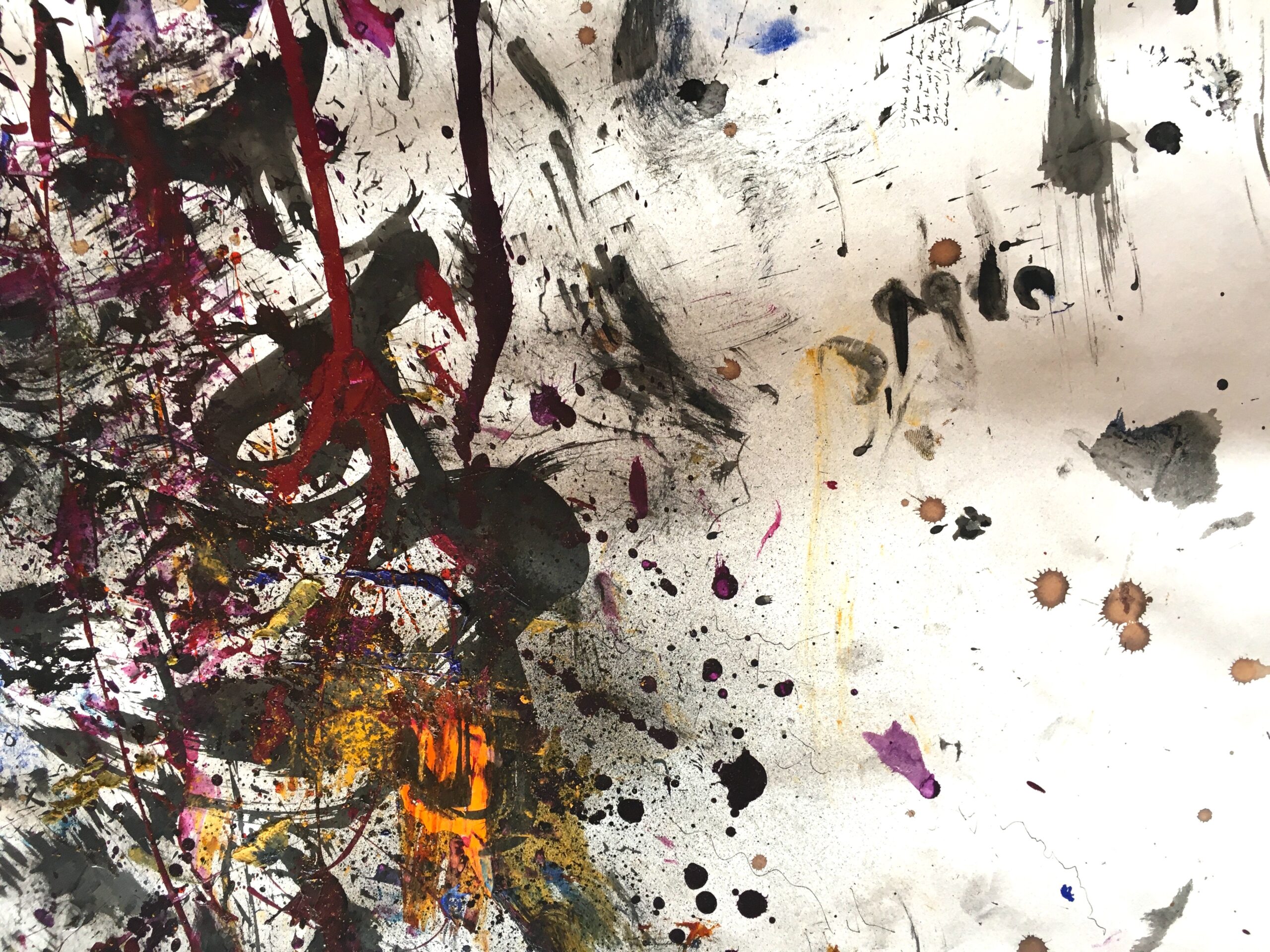
BP: Can you talk about your relationship to colour. Obviously you have an immense amount of black and white work, can you speak to that. Also, what seems like a more recent departure or extension into red. I am thinking of that very strong red canvas that feels besotted with its tone. Also cobalt blue recently in some of your large performative gestural pieces.
IK: For a long time, I didn’t feel much confidence in my ability to use colour. I thought I had some understanding of composition but was never granted the same muscle for colour. I was also much more captivated by the penetrative singularity that black and white works tend to deliver. Somehow, recently, I feel this has all shifted.
At the beginning of the coronavirus pandemic, I moved out of London to spend some time with my family in the countryside and I didn’t have all my usual materials, only a big bag of oils. This forced me to find new forms in new materials and new restrictions. I also developed a kind of colour language. For some reason, I delved deep into the red. Everything was red or permutations of red. Everything was raw and pungent and bleeding. Now suddenly a shift towards a gentler and clearer blue has emerged. In retrospect I see this as an emotional shift or a response to the world as a whole. At the beginning of the pandemic my grandmother died, she was incredibly dear to me, and whilst I felt I was somewhat at peace with her passing, my paintings were rife in abstractions of blood and corpses and brokenness. Now I see something new arising, something that just says, “we are where we are, and that’s groovy”.
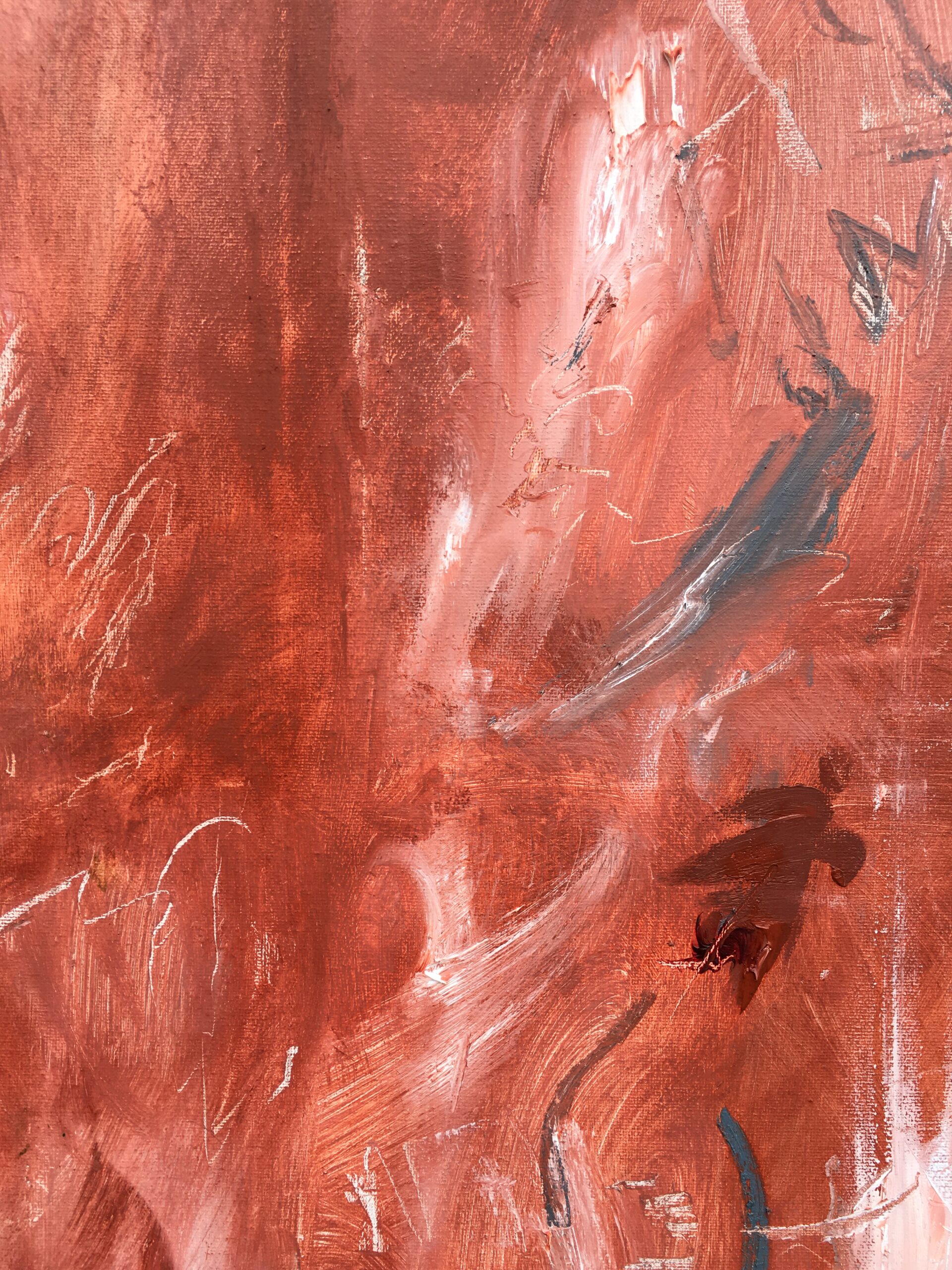
BP: Can you talk about process from any angle that you feel compelled to share. I am thinking of process in terms of you going to that space near the lake one day to make a painting outside to then hang it in a tree to dry. Other times I witness you in larger spaces painting on the floors or walls. Can you talk about how that changes the outcome of your work.
IK: Most of my works begin on the floor, with me sitting on a large sheet of paper, trying to understand the paper. There is something sacred about the floor. In Indian culture all the most important things happen on the floor. We eat on the floor, we pray on the floor, and if you go to a concert the musicians are always seated on the floor. I think it signifies that something sacred is about to commence. It connects you to the earth, to the ground from which we sprang, and recontextualizes your position in this world; it beckons a posture of humility, and of service. I feel this starting point to be crucial to the trajectory of a painting. If it doesn’t start on the floor then I will at least try to embody this similar energy or state in some way.
I really enjoyed the tree installation piece that you mentioned as it truly got to the centre of this concept. This was a project done in Hyde Park where using plant materials, I made a huge painting that was then hung in a great willow tree. This strange circularity of using the environment to create the work and then returning it to its source, offers a wholesomeness to the process. As a creator, that is very nourishing. I find the most inspiring work for me comes from this impetus to say thank you, or to offer something to a tree or to a place – a place that helped spur this moment of creation.
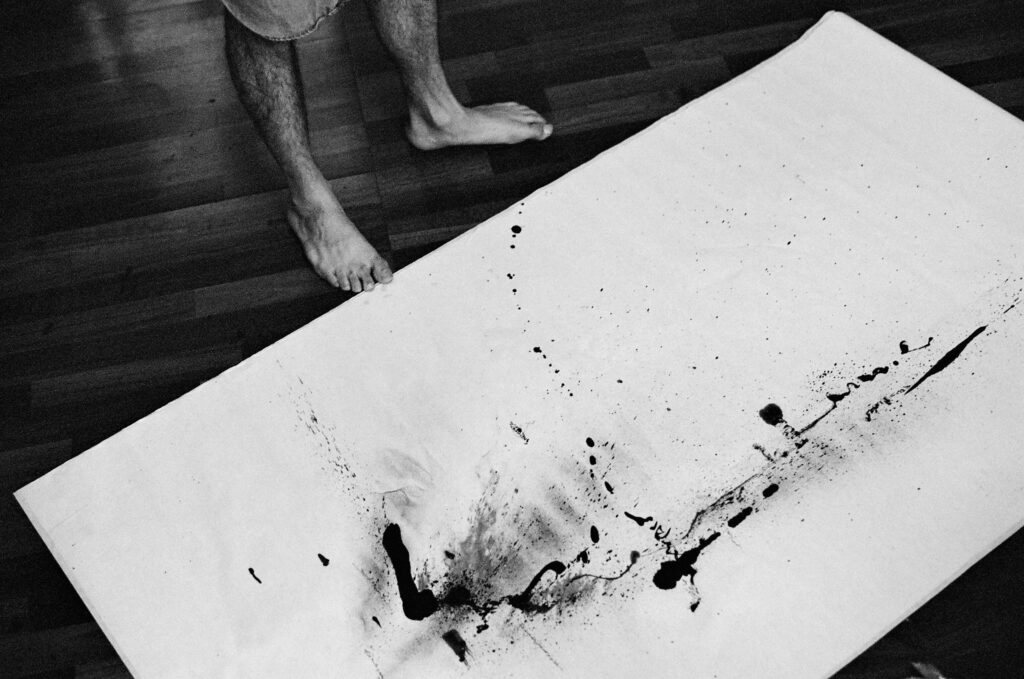
BP: Can you talk about your trip to China, which is when I became fascinated by your work, I know you went to study with a Chinese Master, I believe in calligraphy, in a remote mountain area. Can you talk about the catalyst for making that pilgrimage and the different elements that evolved. I know at one point you made a hair brush to paint with. I am very interested in how pursuing things like as a method to alter your thinking or person.
IK: I didn’t actually study with a master in China, but I was staying in an old Qing dynasty house which was built for a famous master calligrapher 150 years ago. It was an incredible place, full of lingering ink spirits.
Ironically, it was so isolated that it was impossible to get any art or calligraphy supplies. The village just had one shop, open for 1 hour a day, and it only sold cigarettes and sour plums.
I took to the mountains to collect my supplies. I came across a very long bamboo stick, and using my own hair, decided to use it to make some brushes – these became my main tools for the following weeks. I can’t say these were built to the quality of a master brush maker or that I use enough conditioner in my hair but there is some power or life that is generated from living within this improvisational state. For me, this is the essence of painting. When I roll out a sheet of paper or canvas I don’t want to know what is going to happen. I want to be part of what is happening in real time as it happens. If I can draw directly from the environment then I will – this is my ideal state – fully dissolved into whatever lies around me.
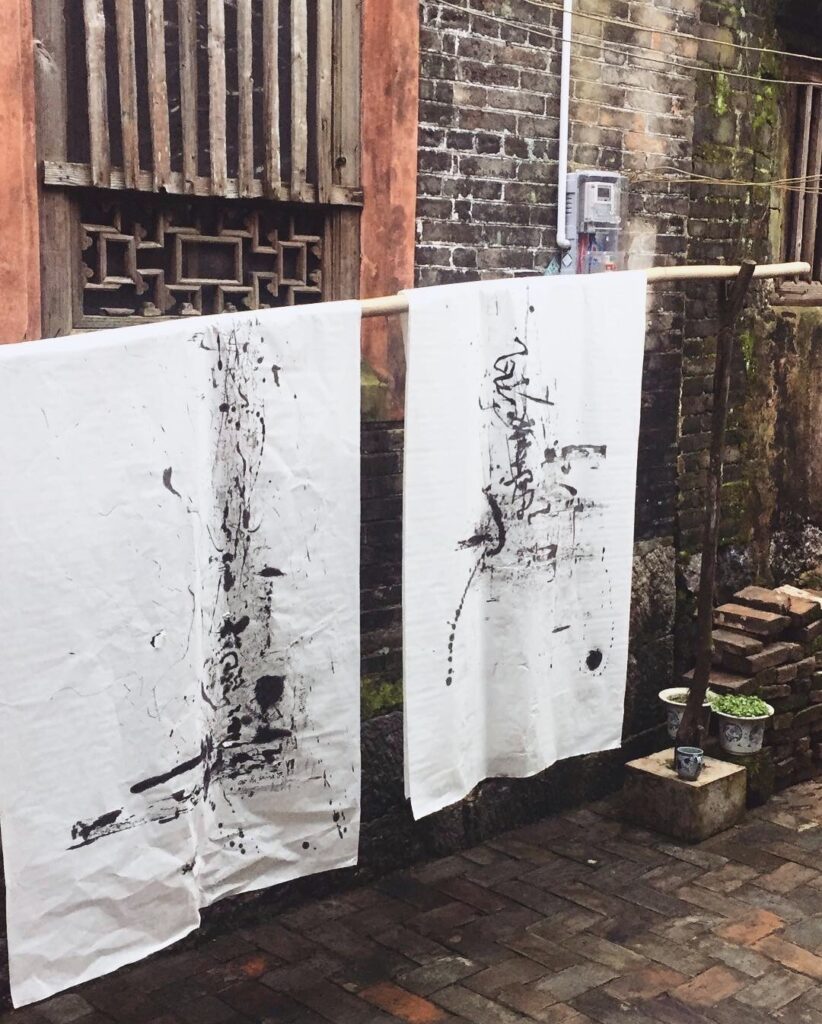
BP: Can you speak to your background and interest in Philosophy, in the sense of how it influences your work or not. Or the awareness level it holds for you.
IK: At the minute, the main function of my work is to re-calibrate the amount of free will I think I have. Like many of us, I wander around the world thinking I am this grand separate thing that can impose its will and its desire upon the universe. But I really don’t believe we have this much agency, nor would I ever want it. The greatest times of vitality in my life are when I let myself be governed by the universe and accept that it holds a greater knowing and greater imagination than I do.
This is an incredibly hard thing to do, you have to let go of so much; so much education, so much ambition, so much ego. But the one place that I find I can do this is when I paint or write. I have learnt quite viscerally that when I impose my will on a painting it always delivers something less than the image or idea, that I have slowly become attached to. But when I spend my time listening to the sound of the space, the unique texture of the paper, the direction the ink chooses to move, the whisper that each moment gently dictates – there is a strange power and freedom that comes. Some magic occurs, you have no idea where you are going, or how to get there, but you have a faith that you will. Most of what my practice involves is exercising this muscle or non-muscle. The hope is if for an hour or two a day I can engage this, then it will filter into my life and generate a humbler perspective of how I see myself within this world. I think this is the most fundamental philosophical aspect of my work. This perspective has arisen out of quite a deep inquiry into mysticism and philosophy as a whole, as well as meditation practices, but I no longer engage intellectually with the intricacies of a philosophy in the moment of creation. I used to have very precise philosophical ideas that I would want to communicate in my work, but as time went on I have found a faith that if these are held within the subconscious they will automatically find their way into the work. And I see this happen all the time – I love it – it allows me to experience my own work with the joy, freshness, and the inquiry of a viewer rather than the arrogance of a creator.

BP: How did you begin making art, can you expand a bit on your history as an artist.
IK: As a child I was always drawing or writing, or making something. I liked expressing things even if I didn’t know how to or what to express. This was a very casual practice until about 12 years ago when I got very sick. This changed my lifestyle quite dramatically. Every night, while my friends were going out and partying, I would come home, sit and drink tea for a few hours and just contemplate the world. This practice of nothing and tea had a huge impact on the way I began to perceive and interact with the world.
Being limited physically, I started to find a world of movement in thought and in the simplest of sensation. I became obsessed with understanding the world in the context of it being a macrocosm of the body.
This led me to quite radical shifts in my conception of reality. I started thinking about everything in terms of boundaries and how the boundaries between things are not as fixed as they appear. Initially these ideas were very abstract and unformed and they naturally took the guise of small folklorish ink drawings, absurdist poems, and love letters to mother nature. As my ideas developed a literalism emerged. I started writing papers and giving talks – tightening what was becoming a very holistic body of thinking. But at the center of this thinking was a reverence for the ineffable and a desire to re-calibrate our rationality. I realised that what I was trying to say could never in its truest form express itself within the constructs of a rational philosophical model. The only way to attest to the essence of what I was talking about was to return to an artistic medium that doesn’t get caught up in linear understanding and accepts the inherent paradoxical nature of life. It was only after all this that my artistic process was strongly anchored within a meaningful metaphysic, and yet simultaneously departed from the metaphysic that birthed it. I still see my practice as some form of inquiry into this but it’s very gentle. This movement from philosophy to art/poetry is a shift from interrogating the world to spending time with it, which inevitably births a form of learning – a kind that can’t be held. It’s a return to the liturgy of tea – the place from which everything grew. Now when I roll out a canvas, I am no longer trying to grapple with anything, I just sit down to have a cup of tea with the angels and find that absurd forest milk the mystics are pining after.
BP: Also how you came to be a poet. It feels like you have varied styles to some extent but obviously the constant is you. Can you talk about the reoccurring content or themes in your poetry.
IK: When I started this grand philosophical quest, the first ideas all appeared as poems or short inscriptions you might find in a cave or on a dusty tablet somewhere. They were words that you knew meant something but you have no idea what exactly. I loved that something could be so meaningful and meaningless at once and that this spurred its beauty. But I still wanted answers. This unnerving obsession with truth, is what led me out of poetry and then led me back into it. I have come to realise that this – this moment as it is – unspoken about – is truth and it’s always different in each moment. I think poetry has a built-in understanding of this. We are talking, we are writing, but about what? Something completely ungraspable, something that is true to a moment, then vanishes, and leaves its ghost. I think this is why I have fallen in love with poetry and with language in general. A lot of my fascination with language comes from the fact that it holds so much baggage. We use language to write shopping lists, legal documents, emails to our plumber. This creates a pressure of meaning and intelligibility that language drags around with it. We don’t put this same pressure on a piece of music or a painting. This creates a challenge within an aesthetic use of language – a challenge to re-calibrate it and rebind it to its natural poetic source. For this reason, my writing seems to be concerned deeply with abstraction, trying desperately to find a code within the language that allows language to free itself from itself and create a space to say what it truly wants to say. I also like to use paintings as a way of doing this. When I paint there are always tiny micro poems hidden within the paintings and woven into the imagery. Often these take the form of mantras that appear in the moment, and repeat continuously throughout the painting. The themes around these poems seem to always point to the divine incantations that yearn for a here that doesn’t always feel here. Even when my poetry is bloody or gruesome, it’s inquiring into the divinity of this gruesomeness; how is a baby dying in her mother’s arms divine? Similar questions will continue to repeat and the poem searches to answer them not by answering them but by abstracting them from their stupidity. At the end of it, everything I write seems to say the same thing: Thank you – Thank you for allowing me to be here – here with you.

BP: Is there a relationship between your poetry and visual work that is direct or is it something that’s floating in the ether and you don’t attach that much importance to it.
IK: Most of my paintings and poetry are searching for the same thing, this is what really binds them. They are searching for a line, an invisible gateway out of their own self. It’s a difficult thing to explain but I guess it’s something that emerges out of a type of balance; a balance not born out of equal or similar quantities of things – colours or shapes, but a balance that arises when this duality shatters….. Yikes I’m starting to sound like that lunatic on the plane you wish would choke on his peanuts…..but one artist that I believe achieves this almost unfalteringly is Juan Miro. I see this line which is in fact a circle present in almost all his paintings. That’s all I’m after, that simple juicy dollar dollar miro magic.
BP: Your most recent exhibit was at Port Tsuyama in Japan. I am interested in how that came to fruition. That’s a very sacred Japanese institution and place to exhibit. How did that inform the work you produced for the show. And of course we cannot talk about PT without bringing up Kaneko, I don’t know what to ask exactly, perhaps it’s just a pause of reverence for her.
IK: A delegate of the Japanese embassy came to interview me for a book that they were creating about artists outside of Japan and she showed my work to the curator of Port Art and Design Tsuyama who then approached me. It was really quite a special opportunity. Port Tsuyama is such a magical space and it resembles everything I look for in a gallery. I wanted to create a religious space that didn’t hold any of the baggage of a religion. Port Tsuyama was perfect for that – 6 meter high ceilings, the sound of quiet bricks, and the sacred smell of kodamas wandering the earth.
Shamefully, I had never heard of Misuzu Kaneko until the curator asked If I wanted to do a joint show with her which opened me up to the crypt of Kaneko. I think she is brilliant. She has a unique ability to display a truly simple and childish wonder that effortlessly sits alongside such crisp and heartbreaking existential clarity. It was a great honour to share space with her.
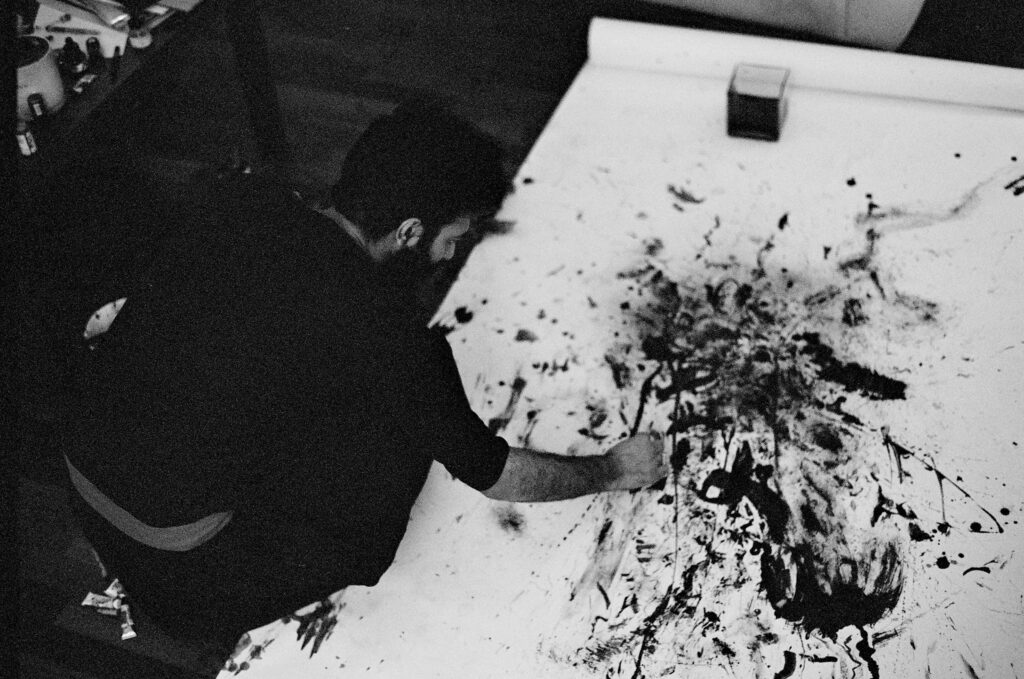
BP: Since I do know you, I am aware you have an incredible capacity for depth of emotion and sentiment but you simultaneously seem to understand detachment from this. It’s a kind of beautiful version of detachment, a more spiritual side. I feel like you have a profound handle on this but I don’t know if you see it that way.
IK: Aww Brit that’s very kind. I think at the base of everything the world is just funny, everything is endlessly absurd. Sure, there is so much pain, sadness, joy, violence, chaos, tenderness and I want to be connected to that to feel it and experience life in its different permutations – and try to derive a certain empathy from that. I also think at its most granular level everything is just absurdly humorous. The fact that this world exists and we exist as beings in it, experiencing this array of feelings, is so widely improbable and infinitely mysterious – that by itself is an immense source of joy and comfort for me. I think if you see everything emerge from this absurdity you can simultaneously journey into the raw humanness of it all whilst maintaining some sense of its larger beauty. Really everything I do aims to act as prayer to this absurdity, a way to remember this force. I guess that’s how I conflated these two seemingly opposite states…..but it’s not always easy.
BP: For me one of the strongest reactions I have to your work is that I find your visual language very difficult to put words to that aren’t a version of formalism. And even at that it’s like trying to formalize Cy Twombly. It feels very incorrect to say you make instinctual work as that is never how it occurs to me. I sometimes sense fragments of ritual or trance. It always feels like there is ‘something at work,’ some presence or intense focus.
IK: Wow thank you. I think this is the greatest compliment. Obviously I love Cy Twombly so to be mentioned in the same breath offers some nice ego cola. But also I think being able to create a visual language that can’t be conceived or formalised is really what makes a piece of art valuable. Life is not conceivable nor formal so how can a direct response to it be so. It’s really a joy to hear this perception or reaction to my work.
But if we are talking in such terms, I think instinctual makes some sense to me as it makes sense because it suggests a thoughtlessness but I guess where it doesn’t make sense is because instinct makes it sound like something I have or that I own, or something that I am leading. But really my greatest work tends to come about when I put my energy into trying to listen rather than create. Instead of asking – What do I want this painting to say? What do I want it to mean? What do I want it to look like? I try to ask the painting – What would you like to be? Where would you like to go?What’s your favourite flavour of ice cream? When I can truly allow this to exist at its apex, then this hyper focus trance manner emerges. And what could be called instinct begins to take the guise of submission.
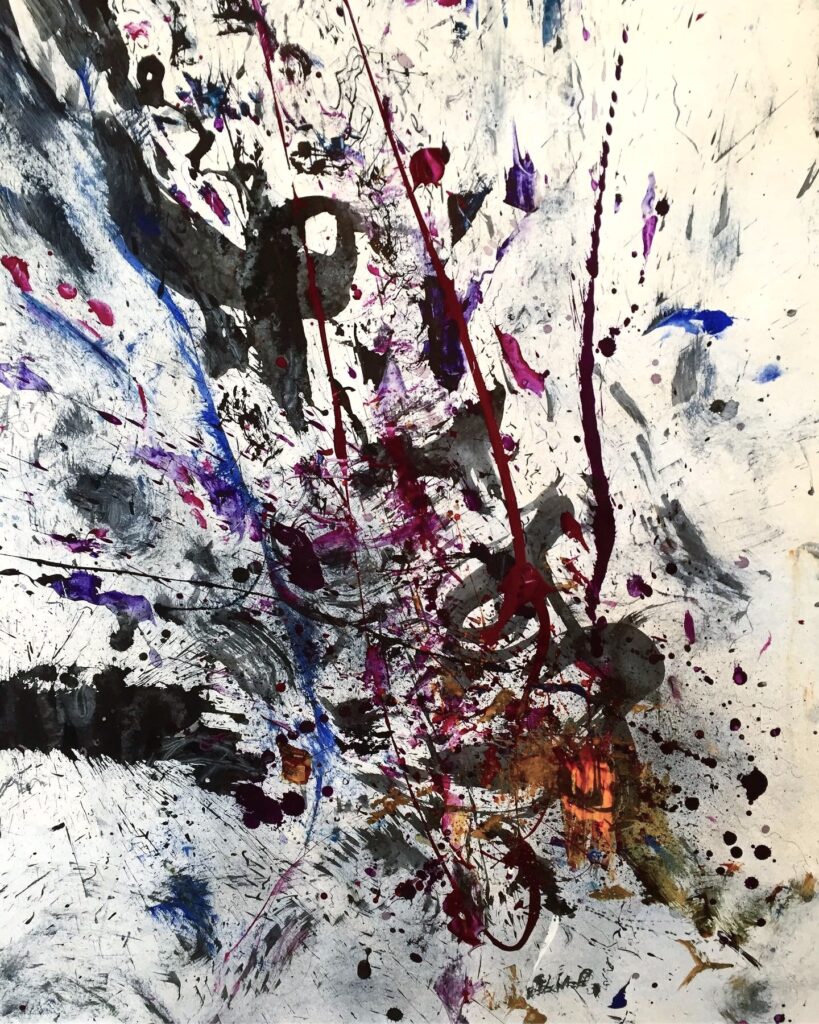
BP: I wonder what you hope you communicate to people or give to people. Is there a need to impart or contribute in a specific way. Are those considerations. How does that function for you as an artist.
IK: At the minute I’m wanting to create non doctrinal religious spaces. Places people can go and experience something liturgic, without it holding all the heavy weight of a church or temple. For me, the process of creating these paintings or texts holds a very liberating quiet that is somewhat symmetrical to prayer. My hope is that these pieces offer a gateway into the moment of their creation and into this freedom.
There are deeper philosophical ideas held within the work that I would like to offer. I believe the paintings or texts should speak to this and not me. The reason I love art is because it’s non instructive. The meaning and guidance that can be intuited from it is co-creative and so precisely unique to the viewer.
If I can somehow offer someone some guidance or meaning that emerges out of this state of quiet without either of us ever knowing this happened or how such things could be articulated then that is good enough for me.
Images courtesy of Ilyas Kassam: Photographs 3,5,7 by Asia Stac